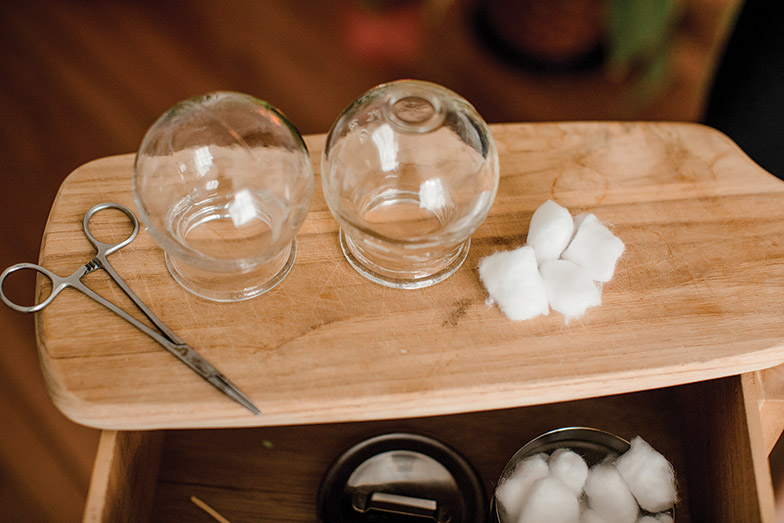
Helping People Help Themselves
By Sandi Tomlin-Sutker
Natasha Kubis came to her healing path even before she was 11 years old. “I had struggled with sleep and digestive issues. My parents had good insight and did not want to medicate me, so they searched for healthy alternatives. Complementary medicine, including acupuncture and yoga became part
of my routine.”
She says she was not very interested in sports as a child, so yoga offered a way to get exercise and manage stress. “Yoga has always been an important part of my physical and mental well-being; a part of my spiritual practice, the way I stay sane.” She cut a deal with her early yoga teacher to exchange classes for babysitting, so she says, “I did a lot of babysitting!”
Born on a flower farm in Maui, Hawaii, Natasha grew up spending her summers on the island, and her school year in a picturesque surfer town on the Jersey Shore. “I have been on a plane since I was two years old; I love to travel and have been all over the world: Morocco, France, Spain, Scotland, Italy, and Eastern Europe, to name a few. It has always been important to me to see how other people exist, outside the American mindset.” That love of cultural diversity was part of why she was always interested in East Asian and Indian philosophy and their ancient models of health. “I hope my next big trip will be Japan!”
She chose Seattle for her college years and then moved back east for acupuncture school at the Eastern School of Acupuncture and Traditional Medicine in Montclair, New Jersey, about an hour outside New York City. “After college, I felt the desire to explore the mechanisms of acupuncture, since it was something that had helped me in my youth. My training was nearly 3,000 hours and I was able to acquire my Master’s Degree in Acupuncture in 2009.”
“I spent my twenties living in NYC and loved that lifestyle. It’s a great place to grow and evolve. I was inspired by my surroundings. NY is a cultural smorgasbord of eight million people with their languages, customs, and religions all coexisting within a rich and colorful framework.” She also found it to be a good place to start her career. After years of living in the hustle and bustle of city life, she felt a bit depleted and began looking for a more peaceful place. “Asheville was a great remedy. There is the best of everything here: a little downtown with lots of art and music, a delightful restaurant culture, a health conscious mindset, and a breathtaking landscape. In the three years I have been here I have found peace, solace, and a warm embrace by the community.” However, she kept her practice in NYC and travels there every few weeks. “I get my “big city” fix once a month and come back to the mountains to get restored and catch up with patients here.”
Why Complementary Medicine?
Natasha stresses that acupuncture is not a magic bullet that allows us to take a back seat on our road to health. “Sure, most of my patients take a long restorative nap while they are on the treatment table, but I emphasize that once you leave the office, an overall healthy lifestyle is what yields sustainable results.” There are no added medications or quick fixes; the treatments aim to rewire the body to function more optimally. “Acupuncture began around 2,500 – 5,000 years ago in China. It involves the insertion of tiny, sterile needles into acupuncture points along the body. There are over 2,000 of these points located at nerve endings, so we are essentially stimulating the nervous system. It is great for a variety of health issues, and modern science has given us a glimpse into the mechanism of acupuncture, especially when it comes to pain management.” This point is particularly important during the current opioid crisis with its high addiction and mortality rates. Acupuncture stimulates the body’s natural ability to suppress pain without the over-dependence on painkillers. “Studies have found acupuncture points at sites of high-density neuro-vascular structures. When we stimulate those areas, we are promoting secretion of naturally occurring neurotransmitters like endorphins, which help minimize pain.”
Acupuncture is called complementary medicine because it is often used in collaboration with conventional treatments. In addition to Natasha’s practice in East Asheville, she works with Dr. Vicky Scott at Asheville Gynecology and Wellness in South Asheville. “It is a great joy for me to share space with an integrative practice that offers traditional GYN care as well as holistic and lifestyle medicine for women.” Acupuncture can be a wonderful option for women’s health and can be a supportive option to traditional care. Some areas on which Natasha focuses are fertility support, PMS, endometriosis, and menopause.
Focus on your immune system
“We have this innate ability to heal ourselves; it is called our immune system. Some of us need a bit more support. I like to think of myself as a helper, helping people help themselves. When people come to me, I am often their last resort. They are depleted, have been dealing with pain and nothing has helped.” She asks her patients to meet her halfway. “It is a collaborative effort. I give people homework, exercises, we talk about nutrition and diet. I tell them at the beginning that this is a partnership, partnering up for their recovery. Healing takes time and effort on everyone’s part.”
I like to hold space for people to relax when they are being treated. It is important to me that patients feel heard and taken care of.” She combines acupuncture with cupping, electro-acupuncture with a TENS unit, yoga, massage, and reflexology.
“For some people, for instance with sciatic pain, I incorporate a personalized yoga protocol (a series of poses to practice) based on the patient’s therapeutic needs.” She completed her yoga teacher training in Asheville and feels some of the best teachers in the country are here. “I have a daily personal yoga practice that resets me; I would be a different person without it. It keeps me open and ready to be the best practitioner I can be.”
“In our culture, we are used to throwing a medication at something, and being really passive in our healing process. Of course medicine is important, but it is also important and empowering to take an active role in your own health and wellbeing.” Natasha’s tool kit of acupuncture, cupping, and yoga gives her patients an opportunity to be fully involved as she helps them help themselves!
You can contact Natasha Kubis, L.Ac. at www.essential-well.com 917.576.9198
Sandi Tomlin-Sutker is a freelance writer and editor. Contact her at [email protected]


